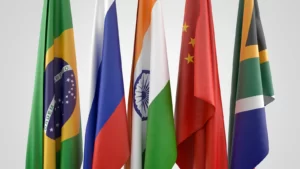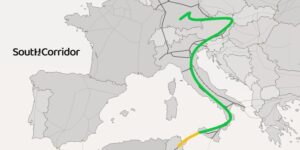- In August 2023 President Lula launched the “New” Growth Acceleration Program in Brazil;
- Despite criticisms of the original project, the New PAC aims to complete the projects of its predecessor and add projects with a focus on sustainability;
- The success of the New PAC could align Brazil with global infrastructure projects and give the country a more influential voice in the international community.
Announced by President Luiz Inacio Lula da Silva, Brazil launches the “New PAC” (Growth Acceleration Program). A new version of its government plan aimed at boosting the country’s economic development and infrastructure, just like other countries around the world do.
As governments seek to strengthen their infrastructures to face the challenges of the 21st century such as growth and sustainability, it is worth highlighting how the “New PAC” intertwines with global trends, sharing goals, challenges and perspectives that transcend national borders.

What is in the “New PAC” of the Brazilian Government of Lula
The “New PAC” appears as a new version of the Growth Acceleration Program (PAC), a government plan in Brazil, which was announced by President Luiz Inácio Lula da Silva on August 11, 2023. principally, to stimulate the country’s economic growth, through targeted investments in areas such as infrastructure, housing and sustainability with a budget of 1.7 trillion in Brazilian Reais, thereabout 2.6 million American dollars.
Taking a step back, the PAC, launched during Lula’s first presidential term in 2007, incorporated a wide range of projects focused on infrastructure.
The original PAC was intended to stimulate the economy through large public investments in fields that included transport, energy, housing, basic sanitation, health, education and other key sectors.
Its objective was not only to boost economic growth, but also to improve the population’s quality of life by providing essential services and adequate infrastructure.
The program was divided into several thematic axes, each one oriented to a specific sector of the economy and society. Such axes involved projects ranging from the construction of roads, railways, ports and airports to popular housing, sanitation projects, as well as investments in energy.
Over time, Lula has not escaped criticism regarding the execution and effectiveness of these initiatives, with questions ranging from delays, budget overruns, corruption, to the lack of transparency in certain sectors.
Despite the promises of the original PAC, it faced a number of notable challenges and criticisms, with the following aspects standing out:
- Implementation Delays and Challenges: Certain projects failed to materialize as planned, which led to delays and schedule disruptions.
- Extrapolated budgets: Some initiatives exceeded the initially established financial limits, resulting in higher final costs than previously estimated.
- Lack of Clarity in Resource Allocation: There were legitimate concerns about transparency in resource allocation and selection of projects that would receive investment.
- Excessive bureaucracy and lengthy processes: The excessive bureaucratic burden and slow processes may have hindered the effective implementation of projects.
- Complex Environmental and Social Challenges: Certain infrastructure developments raised concerns about negative environmental impacts and relocations of local communities, factors that provoked controversy.
- Changes in Priorities: Subsequent government changes may have implied changes in investment priorities, potentially affecting the continuity of some projects.
- Suspected Corruption: There were also allegations of misconduct and corruption related to the implementation of former PAC projects in Brazil. These allegations ranged from the selection of companies to carry out the projects to the allocation of resources and tenders.
Even with these challenges and criticisms, the PAC played an important role in the scenario of economic and social development in Brazil, promoting investments and transformations in several areas.
What are the main investments of the New PAC and how they are divided (focus on sustainability)
The projects were categorized into nine major areas, and also by state, each with its corresponding subdivisions:
- Efficiency and sustainability in transport (BRL 349.1 billion):
- Highways (BRL 185.8 billion)
- Railroads (BRL 94.2 billion)
- Ports (BRL 54.8 billion)
- Airports (BRL 10.2 billion)
- Waterways (BRL 4.1 billion)
- Inclusive social infrastructure (BRL 2.4 billion):
- Culture (BRL 1.3 billion)
- Sport (BRL 320 million)
- Public Security with Citizenship (BRL 800 million)
- Construction of sustainable and resilient cities (BRL 609.7 billion):
- Minha Casa, Minha Vida (BRL 345.4 billion)
- Housing financing (R$ 160 billion)
- Urbanization of favelas (R$ 12 billion)
- Sustainable urban mobility (BRL 48.7 billion)
- Solid waste management (BRL 1.8 billion)
- Disaster prevention – containment of slopes and drainage (BRL 14.9 billion)
- Sanitary sewage (BRL 26.8 billion)
- Access to water for all (BRL 30.1 billion):
- Water supply (BRL 10.8 billion)
- Water infrastructure (BRL 11.9 billion)
- Supply of water to vulnerable populations (BRL 3.1 billion)
- Revitalization of watersheds (BRL 4.3 billion)
- Digital inclusion and connectivity (BRL 27.9 billion):
- Connectivity in schools and health units (BRL 6.5 billion)
- 4G expansion and 5G implementation (BRL 18.5 billion)
- Infovias (BRL 1.9 billion)
- Postal services (BRL 856 million)
- Digital TV (BRL 154 million)
- Transition and energy security (BRL 540.3 billion):
- Energy generation (BRL 75.7 billion)
- Light for All Program (BRL 13.6 billion)
- Energy transmission (BRL 87.8 billion)
- Energy efficiency (BRL 1.8 billion)
- Oil and gas (BRL 335.1 billion)
- Mineral research (BRL 307 million)
- Low carbon fuels (BRL 26.1 billion)
- Investments in education, science and technology (BRL 45 billion):
- Basic Education (BRL 26.4 billion)
- Professional and technological education (BRL 3.9 billion)
- Higher education (BRL 4.5 billion)
- Innovation and research (BRL 10.2 billion)
- Improvement in the health area (BRL 30.5 billion):
- Primary care (BRL 7.4 billion)
- Specialized care (BRL 13.8 billion)
- Preparation for health emergencies (BRL 272 million)
- Health industrial complex (BRL 8.9 billion)
- Telehealth (BRL 150 million)
- Stimulating innovation in the defense industry (R$52.8 billion);
- Research, development and acquisition of large-scale equipment for the Air Force (R$ 17.4 billion)
- Research, development and acquisition of large equipment for the Navy (R$ 20.6 billion)
- Research, development and acquisition of large equipment for the Army (R$ 12.4 billion)
- Research, development and acquisition of large equipment by the General Staff (BRL 2.4 billion)
Along with this, the Federal Government has committed to making the new edition of the program more attentive to environmental issues and the ecological transition.
How the Novo PAC intends to make partnerships between public and private investment to invest in infrastructure projects in Brazil
The New PAC aims to create partnerships between public and private investment to boost infrastructure projects in Brazil, since the State alone would not have enough resources to invest in the infrastructure that the country needs to develop.
These partnerships can be an effective way to mobilize financial resources, technical knowledge and agility in the execution of large-scale projects.
Here are some ways the New PAC can implement these partnerships:
- Concessions and Tenders: The government can launch concessions and tenders for infrastructure projects such as highways, railways, ports, airports and other facilities. Private companies can compete to operate and maintain these assets for a specified period, in exchange for a remuneration or toll.
- Public-Private Partnerships (PPPs): PPPs involve a deeper collaboration between the public and private sectors, where both parties share risks and responsibilities in the design, financing, construction and operation of projects. This may include transport infrastructure, sanitation, energy, among other sectors.
Partnerships between public and private investment can be advantageous, as they allow the government to leverage the resources and expertise of the private sector, while sharing risks and responsibilities.
In addition to the contribution from the Federal Budget, the New PAC will rely on resources from state-owned companies, funding made available by public banks and contributions from the private sector, including concessions and public-private partnerships (PPPs).
The expectation is that the total amount of investments will reach the expressive mark of BRL 1.7 trillion, distributed in such a way as to comprise BRL 1.4 trillion in the period from 2023 to 2026 and BRL 0.3 trillion after the year 2026.
The projected distribution of resources comprises the following proportions:
- General Budget of the Union: BRL 371 billion (BRL 240 billion until 2026 and the remainder allocated to works that will exceed this period);
- Contribution from state-owned companies: R$343 billion;
- Amount from financing: R$362 billion;
- Private sector participation (including concessions and PPPs): BRL 612 billion.
It is worth mentioning that the global amount does not include an amount of up to R$80 billion, as proposed by the Ministry of Transport in relation to contractual renegotiations. This process is awaiting the approval of the Federal Court of Accounts (TCU) for the due homologation.
How the New Pac is similar to other major infrastructure projects in other countries around the world
The Brazilian “New PAC” has similarities with other large infrastructure projects in different countries around the world. The quest to boost economic growth, promote sustainability and attract investments through partnerships between the public and private sectors is a global trend.
I highlight below some examples of how the “New PAC” can resemble initiatives in other countries:
- United States (Infrastructure Plan/ IRA): The US government has also proposed an infrastructure plan that aims to modernize the transportation network, improve water quality, invest in clean energy, and expand broadband access. Both plans share the goal of revitalizing infrastructure, boosting the economy and creating jobs. Another relevant project is the IRA (Inflation Reduction Act). It is a bill intended to fight inflation and strengthen the economy. It proposes exemptions and incentives for companies so that, together with the increase in government spending in areas such as infrastructure, energy and education, it can make products and services cheaper, especially with sustainable energy.
- China (Belt and Road Initiative/ Made in China 2025): China is implementing the outward-facing Belt and Road Initiative, an ambitious global infrastructure project that seeks to connect countries through transport, energy and telecommunications networks. In addition to this, there is also the “Made in China 2025” project, which is China’s economic strategy to become a global leader in high-tech sectors by 2025. It aims to boost innovation and national production in areas such as artificial intelligence, robotics, biotechnology and renewable energies. It seeks to reduce dependence on foreign technologies, promoting domestic industry and increasing global competitiveness. Like the “New PAC”, the Chinese initiative also aims to strengthen connectivity and promote economic development.
- European Union (Recovery and Resilience Plan): The European Union has launched a post-pandemic recovery plan that includes significant investments in areas such as renewable energy, digitalisation, sustainable transport and infrastructure projects. These objectives are in line with the emphasis on sustainability and economic growth of the “New PAC”.
- India (Bharatmala and Sagarmala Program): India is implementing the Bharatmala program, focused on road construction and road infrastructure improvements, and the Sagarmala program, focused on port development and maritime connectivity. Both programs share similarities with the “New PAC” in terms of investing in transportation infrastructure to promote economic growth.
- Japan (Growth and Investment Plan): Japan has implemented growth and investment plans aimed at improving the country’s infrastructure, technological innovation and global competitiveness. Like the “New PAC”, these plans seek to boost the economy and improve transportation and energy systems.
- Canada (Investment in Green Infrastructure): Canada has invested in green infrastructure, such as public transport, renewable energy and energy efficiency projects. These investments aim not only to improve infrastructure, but also to address the challenges of climate change, in line with the emphasis on sustainability in the “New PAC”.
In general, these initiatives from different countries share the idea that investments in infrastructure can boost the economy, improve the quality of life of the population and promote environmental sustainability.
The potential geopolitical importance of the New Brazilian Pact
The New Brazilian PAC could become significantly important in geopolitics, especially in a global context where several powers are strengthening their infrastructures and industrialization policies.
While the private sector generally seeks profit opportunities, the role of the State with its more strategic long-term vision becomes crucial in conducting infrastructure investments that can boost economic growth on several fronts.
Infrastructure expansion not only generates jobs and stimulates direct economic activity, but also improves the country’s internal and external connectivity, attracting foreign investment and facilitating international trade.
This, in turn, can strengthen Brazil’s position as an attractive trading partner and a more influential voice in the international arena, facilitating multilateral agreements.
In addition, Brazil, as part of the BRICS (a group of emerging countries that includes Brazil, Russia, India, China and South Africa), could further strengthen the bloc, complementing the growth of other BRICS nations and providing a more balanced solid in the global geopolitical context.
However, it is important to note that the success of the New Brazilian Pact and its geopolitical influence will depend on the effectiveness of implementation and the efficient management of resources.
Furthermore, sustainability and consideration of environmental issues also play a vital role in this context, as the world increasingly turns to sustainable solutions in all spheres to fight climate change.










[…] China’s territorial claims over several disputed areas have raised questions about Beijing’s imperialist ambitions and the impact of these claims on the BRICS group. […]